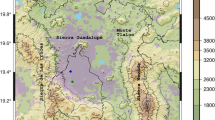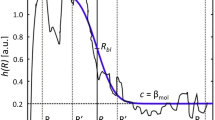Abstract
In this study, we used boundary layer heights derived from lidar in Romania to validate the Weather Research Forecast (WRF) model improved by ARIA Technologies SA in the framework of ROMAIR LIFE project. Lidar retrievals were also compared to the retrievals from meteorological data, both modeled (Global Data Assimilation System; GDAS) and measured (microwave radiometry). Both the gradient and the wavelet covariance methods were used to compute the boundary layer height (BLH) from the range corrected lidar signal, and their equivalence was shown.
The analysis was performed on 102 datasets, spread over all seasons and 3 years (2009–2011). A good agreement was found for the remote sensors (lidar and microwave radiometer) which are co-located and measure simultaneously. The correlation of the measured boundary layer height and the modelled one was 0.66 for the entire dataset, and 0.73 when considering daytime data, i.e., for a well defined boundary layer. A systematic underestimation of the boundary layer height by the WRF during non-convective periods (nocturne, stable atmosphere) was found.
Similar content being viewed by others
References
Angevine, W.M., A.B. White, and S.K. Avery (1994), Boundary-layer depth and entrainment zone characterization with a boundary-layer profiler, Bound.-Lay. Meteorol. 68,4, 375–385, DOI: 10.1007/BF00706797.
Baars, H., A. Ansmann, R. Engelmann, and D. Althausen (2008), Continuous monitoring of the boundary-layer top with lidar, Atmos. Chem. Phys. 8,3, 7281–7296, DOI: 10.5194/acp-8-7281-2008.
Cohn, S.A., and W.M. Angevine (2000), Boundary layer height and entrainment zone thickness measured by lidars and wind-profiling radars, J. Appl. Meteor. 39,8, 1233–1247, DOI: 10.1175/1520-0450(2000)039〈1233:BLHAEZ〉2.0. CO;2.
Freudenthaler, V., M. Esselborn, M. Wiegner, B. Heese, M. Tesche, A. Ansmann, D. Müller, D. Althausen, M. Wirth, A. Fix, G. Ehret, P. Knippertz, C. Toledano, J. Gasteiger, M. Garhammer, and M. Seefeldner (2009), Depolarization ratio profiling at several wavelengths in pure Saharan dust during SAMUM 2006, Tellus B 61,1, 165–179, DOI: 10.1111/j.1600-0889.2008.00396.x.
Hong, S.-Y., and H.-L. Pan (1996), Nonlocal boundary layer vertical diffusion in a medium-range forecast model, Mon. Wea. Rev. 124,10, 2322–2339, DOI: 10.1175/1520-0493(1996)124〈2322:NBLVDI〉2.0.CO;2.
Hong, S.-Y., Y. Noh, and J. Dudhia (2006), A new vertical diffusion package with an explicit treatment of entrainment processes, Mon. Wea. Rev. 134,9, 2318–2341, DOI: 10.1175/MWR3199.1.
Honoré, C., L. Rouïl, R. Vautard, M. Beekmann, B. Bessagnet, A. Dufour, C. Elichegaray, J.-M. Flaud, L. Malherbe, F. Meleux, L. Menut, D. Martin, A. Peuch, V.-H. Peuch, and N. Poisson (2008), Predictability of European air quality: Assessment of three years of operational forecasts and analyses by the PREV’AIR system, J. Geophys. Res. 113,D4, D04301, DOI: 10.1029/2007JD 008761.
Jacobson, M.Z. (2005), Fundamentals of Atmospheric Modeling, 2nd ed., Cambridge University Press, Cambridge, 813 pp.
Löhnert, U., and O. Maier (2011), Assessing the potential of passive microwave radiometers for continuous temperature profile retrieval using a three year data set from Payerne, Atmos. Meas. Tech. Discuss. 4, 7435–7469, DOI: 10.5194/amtd-4-7435-2011.
Löhnert, U., S. Crewell, O. Krasnov, E. O’Connor, and H. Russchenberg (2008), Advances in continuously profiling the thermodynamic state of the boundary layer: Integration of measurements and methods, J. Atmos. Oceanic Technol. 25,8, 1251–1266, DOI: 10.1175/2007JTECHA961.1.
Noh, Y., W.G. Cheon, S.Y. Hong, and S. Raasch (2003), Improvement of the Kprofile model for the planetary boundary layer based on large eddy simulation data, Bound.-Lay. Meteorol. 107,2, 401–427, DOI: 10.1023/A:1022146015946.
Pappalardo, G. (2010), EARLINET: the European Lidar network for aerosol study at continental scale, EARSeL Newslett. 82, 13–18.
Radu, C., L. Belegante, C. Talianu, and D. Nicolae (2010), Optimization of the multiwavelength Raman lidar during EARLI09 campaign, J. Optoelectron. Adv. Mat. 12,1, 165–168.
Rahn, D.A., and R. Garreaud (2010), Marine boundary layer over the subtropical southeast Pacific during VOCALS-REx — Part 1: Mean structure and diurnal cycle, Atmos. Chem. Phys. 10, 4491–4506, DOI: 10.5194/acp-10-4491-2010.
Sorbjan, Z. (1989), Structure of the Atmospheric Boundary Layer, Prentice Hall, Englewood Cliffs, 317 pp.
Stachlewska, I.S., M. Piądłowski, S. Migacz, A. Szkop, A.J. Zielińska, and P.L. Swaczyna (2012), Ceilometer observations of the boundary layer over Warsaw, Poland, Acta Geophys. 60,5, 1386–1412, DOI: 10.2478/s11600-012-0054-4.
Stull, R.B. (1988), An Introduction to Boundary Layer Meteorology, Kluwer Academic Publ., Dordrecht, 666 pp.
Talianu, C., D. Nicolae, J. Ciuciu, M. Ciobanu, and V. Babin (2006), Planetary boundary layer height detection from LIDAR measurements, J. Optoelectron. Adv. Mat. 8,1, 243–246.
Wang, S., L.W. O’Neill, Q. Jiang, S.P. de Szoeke, X. Hong, H. Jin, W.T. Thompson, and X. Zheng (2011), A regional real-time forecast of marine boundary layers during VOCALS-REx, Atmos. Chem. Phys. 11,2, 421–437, DOI: 10.5194/acp-11-421-2011.
White, J.M., J.F. Bowers, S.R. Hanna, and J.K. Lundquist (2009), Importance of using observations of mixing depths in order to avoid large prediction errors by a transport and dispersion model, J. Atmos. Ocean. Technol. 26,1, 22–32, DOI: 10.1175/2008JTECHA 1134.1.
Wu, W.S. (2005), Background error for NCEP’s GSI analysis in regional mode. In: Proc. Fourth WMO Int. Symp. on Assimilation of Observations in Meteorology and Oceanography, Prague, Czech Republic, 3A.27.
Wyant, M.C., R. Wood, C.S. Bretherton, C.R. Mechoso, J. Bacmeister, M.A. Balmaseda, B. Barrett, F. Codron, P. Earnshaw, J. Fast, C. Hannay, J.W. Kaiser, H. Kitagawa, S.A. Klein, M. Köhler, J. Manganello, H.-L. Pan, F. Sun, S. Wang, and Y. Wang (2010), The PreVOCA experiment: modeling the lower troposphere in the Southeast Pacific, Atmos. Chem. Phys. 10, 4757–4774, DOI: 10.5194/acp-10-4757-2010.
Xie, F., D.L. Wu, C.O. Ao, A.J. Mannucci, and E.R. Kursinski (2012), Advances and limitations of atmospheric boundary layer observations with GPS occultation over southeast Pacific Ocean, Atmos. Chem. Phys. 12, 903–918, DOI: 10.5194/acp-12-903-2012.
Author information
Authors and Affiliations
Corresponding author
Rights and permissions
About this article
Cite this article
Belegante, L., Nicolae, D., Nemuc, A. et al. Retrieval of the boundary layer height from active and passive remote sensors. Comparison with a NWP model. Acta Geophys. 62, 276–289 (2014). https://doi.org/10.2478/s11600-013-0167-4
Received:
Accepted:
Published:
Issue Date:
DOI: https://doi.org/10.2478/s11600-013-0167-4




